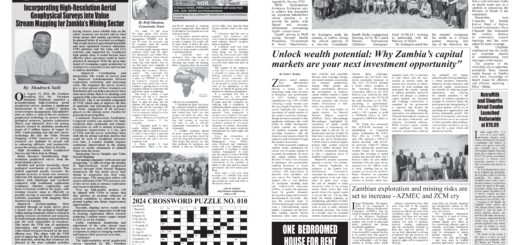Coach Stephen Mukuka: Birthing Business Strategy and Entreprenuership Zambian government’s 2025 SME’s
Notice: Undefined index: catFilterList in /home/zambi/public_html/wp-content/plugins/wp-likes/api.php on line 243

Coach Stephen Mukuka PhD
The Zambian government’s 2025 budget introduces several measures aimed at fostering the growth of Small and Medium Enterprises (SMEs). However, certain fiscal policies, particularly tax increases, may have significant implications for SME operations.
Supportive Measures for SMEs:
1. Credit Guarantee Program Expansion: The allocation to the Credit Guarantee Program has been increased from 386 million kwachas in 2024 to 851.7 million kwachas in 2025. This initiative is designed to enhance SMEs’ access to financing by providing guarantees that reduce the risk for lenders.
parliament.gov.zm
2. Tax Concessions for Rural Businesses: The budget increases the tax concession for businesses operating in rural areas to 20% of the applicable Corporate Income Tax rate for the first five years of operation, extending this benefit to all sectors except mining. This measure aims to stimulate economic activity and SME growth in rural regions.
parliament.gov.zm
Implications of Post-2025 Tax Increases:
While the budget includes supportive measures, certain tax increases may pose challenges for SMEs:
1. Inflation: The reintroduction of a 15% export tax on emeralds, effective January 1, 2025, could lead to higher production costs for businesses in the gemstone sector. These increased costs may be passed on to consumers, contributing to inflationary pressures.
reuters.com
2. Cost of Production: The 2025 budget introduces new revenue measures, including a 10% excise duty on betting and increased fees for foreign artists performing in Zambia. While these measures target specific industries, they may indirectly affect SMEs by increasing the overall cost of goods and services.
unicef.org
3. Cost of Doing Business: The Bank of Zambia has tightened monetary policy to moderate inflationary pressures, raising the Policy Rate to 13.5% from 11.0% and the statutory reserve ratio to 26.0% from 17.0%. These measures are likely to increase borrowing costs for SMEs, thereby elevating the cost of doing business.
parliament.gov.zm
4. Customer Pricing: As SMEs face higher production and operational costs due to increased taxes and borrowing rates, they may be compelled to raise prices for consumers to maintain profitability. This could lead to reduced consumer demand, affecting SMEs’ revenue streams.
Let’s find working solutions and harmony here:
Government Strategies to Encourage SME Growth
1. Tax Incentives & Reduction of Compliance Burden
o Introduce tax breaks or reduced VAT rates for SMEs in critical sectors like agriculture, manufacturing, and technology.
o Streamline tax compliance processes to make it easier and cheaper for SMEs to file taxes.
2. Access to Affordable Credit
o Expand credit guarantee schemes to de-risk lending to SMEs.
o Lower interest rates for SME loans by offering subsidized lending through development banks.
3. Infrastructure & Digitalization Support
o Invest in rural electrification and digital infrastructure to reduce operational costs for rural SMEs.
o Promote e-commerce platforms and training to help SMEs access broader markets.
4. SME-Specific Procurement Policy
o Ensure at least 30% of government contracts are awarded to local SMEs, providing them with guaranteed demand.
o Create mentorship programs where large companies subcontract SMEs in major projects and monitor them on implementation to ensure compliance.
5. Business Training & Formalization Support
o Offer free business registration incentives for SMEs to encourage formalization (Government through various ministries can bear the cost of trainers).
o Provide training on financial management, marketing, and business strategy through government agencies.
SME Strategies to Grow Amidst Economic Challenges
1. Cost Management & Efficiency
o Adopt lean business models by cutting unnecessary expenses and improving operational efficiency. Kaizen models and others have worked in other parts of the world.
o Use renewable energy sources to reduce dependence on costly unreliable electricity.
2. Diversification & Value Addition
o SMEs should diversify their product lines to reduce risk from single-product reliance.
o Invest in processing and packaging to add value to raw materials before selling. Own both your vertical and Horizontal integration processes
3. Alternative Financing & Digital Lending
o Utilize fintech solutions and digital lending platforms to access alternative credit sources.
o Form cooperatives or associations to access group funding and bulk purchasing discounts.
4. Strategic Partnerships & Export Market Access
o Collaborate with larger firms for subcontracting opportunities.
o Leverage trade agreements like AfCFTA to explore export markets.
5. Technology Adoption & Online Marketing
o Shift to e-commerce platforms to reduce reliance on physical stores.
o Use social media marketing to reach more customers at lower costs.
By implementing these strategies, both the government and SMEs can create a more sustainable business environment despite economic challenges.
In summary, while the 2025 budget provides initiatives to support SME growth, such as enhanced credit guarantees and rural tax concessions, the introduction of certain taxes and monetary policy adjustments may increase operational costs for SMEs. These factors could contribute to inflation and higher consumer prices, potentially impacting the competitiveness and sustainability of SMEs in Zambia.
Contact the writer on +260974090904 or steven.mukuka@gmail.com























